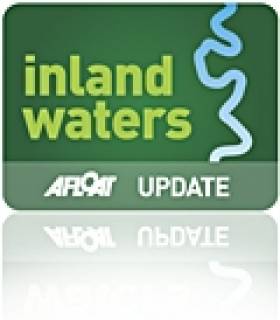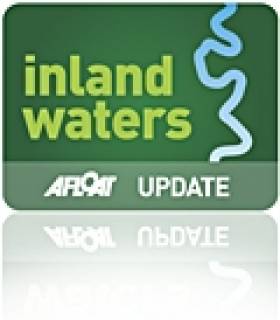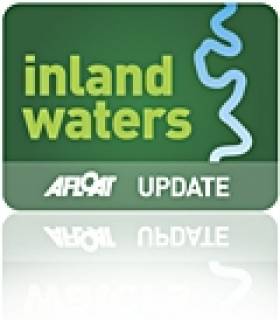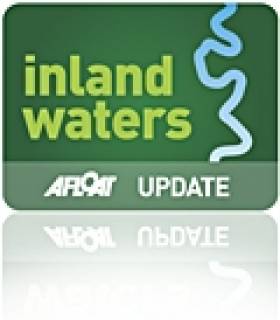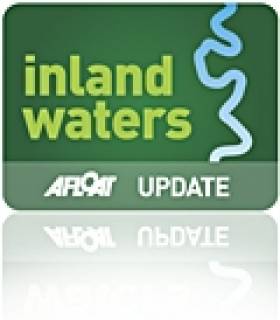Displaying items by tag: Inland
Royal Canal Closes at Lock 12 for Four Weeks
#royalcanal – The Royal Canal will be closed to navigation at Lock 12 Blanchardstown from 23rd January 2013 for 4 weeks to facilitate repairs to the lock gates.
Shannon-Erne Waterway Closes for Repairs to Lock One
#shannonerne – The Shannon – Erne Waterway will be closed to navigation at Lock 1 Corraquill from 29th January 2013 to 31st March 2013 to facilitate repairs to lock gates.
Waterways Ireland Offer Year-long Mooring Permits
#inlandwaters – Waterways Ireland has announced the next set of Extended Mooring Locations which will open on the 21st January 2013. The Extended Mooring Permit (E.M.P) is a change in the permit system on the Grand & Royal Canals and Barrow Navigation allowing for up to year-long mooring permits in a single location.
The fifth set of areas to offer the E.M.P includes locations in Dublin on the Royal Canal at Blanchardstown as well as Thomastown, Co Westmeath. On the Grand Canal Ballycowan, Derries and Gallen in Co Offaly will open. In addition Athy and Ballyteigue both in Co Kildare and St Mullins in Co Carlow which are all on the Barrow will also open for applications on the 21st January.
The full details of the locations including the GPS co-ordinates, the Application Form and Guidance Notes will be available on www.waterwaysireland.org from the 21st January. The application process for the E.M.P for these locations will remain open until the 4th February 2013. The full list of Extended Mooring Locations has been published and is available on www.waterwaysireland.org, in the New Canal Permit section.
Permits will be allocated on a first come first served basis, so to receive a preferred location early application is advised. Applications can only be accepted from holders of valid annual Combined Mooring and Passage Permit. Boat owners without a Combined Mooring & Passage Permit who wish to apply for an E.M.P can do so by ticking the box on the Extended Mooring Application Form and supplying the additional fee.
Applicants will be notified within 28 days of the success of their application. Successful applicants will be required to sign the E.M.P. license and will then have a period in which to move to their new mooring. Enforcement of the 5 day rule will begin in the area following the issue of a Marine Notice.
Applications for the next set of Extended Mooring Locations will continue on a rolling basis thereafter with Waterways Ireland intention to open sufficient locations to cover demand on all of the canals by the end of March 2013.
Boats that cruise and move (staying at a mooring for up to 5 days) will not require an E.M.P. or be in breach of the Bye-laws.
Waterways Ireland will continue to contact permit holders regularly to ensure they are kept up to date with the roll-out of the new permit. All queries about the enforcement of the current bye-laws or the E.M.P should be directed to Shane Anderson, Assistant Inspector of Navigation: Tel no +353 (0)87 286 5726, Email [email protected] .
These changes are necessary steps to improve the management of the canals and waterway amenities for both the navigational and recreational user, so that investment in the new infrastructure and facilities which Waterways Ireland has undertaken is maximised for every user.
Waterways Ireland Dredging of Grand Canal in Dublin Continues
#grandcanal – Waterways Ireland has confirmed that further dredging of the Dublin inner city section of the Grand Canal will commence in October 2012. This work follows on from previous dredging contracts completed on the Grand Canal between November 2009 and April 2011 from Grand Canal Basin to Lock C7 at Portobello. The work is necessary to keep the Canal navigable for a large range of boats.
To facilitate works the Grand Canal will be closed to navigation from October 2012 to March 2013 between Lock C7 at Portobello on the Circular Line and Lock 2, Davitt Road on the Main Line. The work will be executed under contract by L & M Keating Limited and will involve the use of excavating machinery working within the canal property. The works are due to be completed by end of March 2013.
The work will involve the removal of sediment deposits from the central navigation channel of the canals and the clearance of rubbish. Traffic Management Plans agreed with Dublin City Council, have been designed to keep disruption to a minimum.
Extensive discussions have taken place with National Parks and Wildlife Service on measures to minimise the impact of these essential maintenance works on the sensitive habitats established within the canals. All material removed from the canals will be transported to licensed disposal facilities.
The work is funded by the Government under the National Development Plan 2007 - 2013. For further information on the project please visit the Waterways Ireland web site www.waterwaysireland.org and check out the 'Navigation Information, Planned Works' page.
Winter Mooring Season Begins on River Shannon Navigation
#inland – Waterways Ireland facilitates owners to keep their vessels and boats at its public harbours over the winter period on the Shannon and Shannon-Erne Waterways. The upcoming winter mooring period begins on 1 Nov 2012 and will end on the 31 Mar 2013. The fee charged for this facility is €63.50 for the five month period.
Owners wishing to take advantage of this facility are advised to write to the Waterways Ireland Inspectorate, The Docks, Athlone, indicating their intention to take a winter mooring, give the specific location, boat registration number and enclose advance payment of €63.50 by cheque, bank draft or postal order made payable to Waterways Ireland. Credit card payments can also be made over the phone by contacting 353 (0)90 9741165. Payment must be received prior to 1 Nov 2012.
Boats owners that have not contacted the Inspectorate and made the advance payment must continue to observe the mooring time limits for public harbours i.e. the "5 Day Rule", which still applies and will be enforced during this period (Bye-law 17. Mooring and Use of Harbours).
Anyone with queries regarding winter mooring or the enforcement of the Bye-laws should contact the Inspector of Navigation +353 (0)906 494 232.
Shannon Dinghies Enjoy Strong Winds on Waterways Ireland Raid
#inland – Strong winds arrived for the inaugural Waterways Ireland Raid that finishes today and it has produced fantastic photographs including this one above by Nic Compton of Cathy MacAleavey, steering a reefed down Shannon One Design (SOD) dinghy Number 178 across Lough Ree earlier this week. Murphy crewed by her daughter Claudine and Howth YC sailor Amy Wickham sailed from Lanesborough in County Cavan to Lough Ree Yacht Club in just two hours, a journey of some ten miles.
One of the boats taking part in the first Irish Raid was dismasted as the fleet was hit by 25-knot winds crossing Loch Erne on the Shannon River. Former Whitbread sailor and Route du Rhum organizer Sylvie Viant was skippering the Water Wag when the mast collapsed half way down the loch.
"We noticed the mast flexing forward, but the wind was too strong to stop. Then suddenly the whole thing fell forward into the sea," said Ms Viant. "The safety boat came over very quickly, so we weren't in any danger – just disappointed we couldn't carry on sailing!"

Windy conditions for Wags. The boat on the left of the picture lost its mast in one gust. See below. Photo: Nic Compton
The mast was glued back together that evening by a team of volunteers during the stopover at the Lough Ree Yacht Club (LRYC), and Sylvie and her race partner Martine Gahinet-Charrier were racing again the next day.

Come in Number 18, your time is up! A broken spar was quickly repaired. Photo: Nic Compton
Meanwhile, the rest of the crews enjoyed a helter skelter ride in brilliant, but windy, conditions during the fourth day of the seven-day event. Competition was particularily stiff in the Shannon OD class where former Tornado champion Koji Akido vied with Lough Ree Yacht Club commodore Alan Algoe. Despite starting last, the Japanese skipper overtook almost the whole fleet to finish the fourth leg in second place overall, and first in class. First boat home on Lough Ree was the Wayfarer skippered by Monica Shaeffer.
The seven-day event on the Shannon River includes a former Olympian, a transatlantic record breaker, a Whitbread sailor and a former world windsurf champion.
Two local classes, the Shannon One-Design and the Water Wags, joined a mixed fleet of boats in the Open Class to race the 195km course. In a spirit of cross-border cooperation, the first two days of the event took place in Northern Ireland, before the boats crossed the border into the Republic of Ireland and resumed racing down the Shannon River.
First Irish 'Sail Raid' Begins on Inland Waterways
#sailraid – Not since the Vikings has a group of boats set off sailing southwards with such a challenge!
Over 20 sail boats with crews from Japan, France, Sweden England and Ireland will participate in the Lakelands & Inland Waterways International Sail Raid 2012 taking place from 14th to 21st September 2012 from Lough Erne to Killaloe Co. Clare. The crews will sail their boats the distance in 7 days in a series of race stages. An immense challenge but a fun and exciting initiative, this is the first time it has been undertaken in Ireland or Northern Ireland.
A fun, competitive sailing event for teams of 2-3 people, using Shannon One Designs, Waterwags, and an Open Class of boats including Drabscombes, the international teams will be welcomed at Lough Erne Yacht Club for the opening night and briefing before the journey begins. Domestic sailors are also welcome to participate.
Organised by Albacore/Dacmar events "Lakelands & Inland Waterways International Sail Raid 2012" will be run in close cooperation with the Lough Erne, Lough Ree and Lough Derg Yacht Clubs and with the assistance of the Dublin National Yacht Club.
Raid General Manager Jymmy Viant stated "the Lakelands & Inland Waterways International Sailing Raid 2012 is a long distance race with one or two legs every day and a different stopover every night. The "Lakelands & Inland Waterways International Sail Raid" will, to our knowledge, be the first raid run with traditional Irish Sailing Boats, among the oldest classes in the world. We expect international teams to relish this amazing opportunity to explore Ireland's inland waterways in such unique boats".
Eanna Rowe Waterways Ireland, Head of Marketing & Communications and Co-Chair of Lakelands & Inland Waterways stated "The Lakelands & Inland Waterways International Sail Raid is a superb opportunity to bring the awareness of an international audience to Ireland's inland waterways. There is a real opportunity for regular raid enthusiasts from all over the world and for sailors from all over Ireland to join in this unique experience."
Lakelands & Inland Waterways is a tourism product development & marketing initiative of Waterways Ireland, Fáilte Ireland, Shannon Development, Fermanagh Lakeland Tourism and Tourism Ireland.
inland test
inland, inland, inland.....this is a test
#inland – Waterways Ireland has reminded pleasure craft skippers of their duty to facilitate other vessels where berthage is limited by rafting up and to assist others with mooring lines and ensuring safe access to the quay wall.
The notice comes on foot of information received by the authority that on occasion novice masters have been prevailed upon by other masters not to berth outboard of their vessels in harbours when all alongside berths were occupied. It has been reported such incidents have lead masters to depart harbours in failing light and deteriorating weather to seek shelter elsewhere.
The full notice is downloadable below
September Sail Raid to Run from Lough Erne to Killaloe
#inland – The Lakelands & Inland Waterways International Sail Raid 2012 will take place from 14th to 21st September 2012 from Lough Erne to Killaloe. A fun, competitive sailing event for teams of 2-3 people, a different stage takes place each day taking the participants and their friends & family from Lough Erne to Killaloe. Using Shannon One Designs, Waterwags and Open Classes of boats, the international teams of are expected to come to Ireland following other successful Raids in the China Sea, Tahiti, Spain, Portugal, Scotland and Sweden. Teams from Ireland and Northern Ireland are also welcome to participate in this superb adventure.
Organised by Albacore/Dacmar events "Lakelands & Inland Waterways International Sail Raid 2012" will be run in close cooperation with the Lough Erne, Lough Ree and Lough Derg Yacht Clubs and with the assistance of the Dublin National Yacht Club.
Raid General Manager Jymmy Viant stated "the Lakelands & Inland Waterways International Sailing Raid 2012 is a long distance race with one or two legs every day and a different stopover every night. The "Lakelands & Inland Waterways International Sail Raid" will, to our knowledge, be the first raid run with traditional Irish Sailing Boats, among the oldest classes in the world. We expect international teams to relish this amazing opportunity to explore Ireland's inland waterways in such unique boats".
Eanna Rowe Waterways Ireland, Head of Marketing & Communications and Co-Chair of Lakelands & Inland Waterways stated "The Lakelands & Inland Waterways International Sail Raid is a superb opportunity to bring the awareness of a international audience to Ireland's inland waterways. There is a real opportunity for regular raids enthusiasts from all over the world and for sailors from all over Ireland to join in this unique experience."
Lakelands & Inland Waterways is a product development & marketing initiative of Waterways Ireland, Fáilte Ireland, Shannon Development, Fermanagh Lakeland Tourism and Tourism Ireland.
To find out more about the event or to join in email [email protected] or telephone +33 297 57 94 00.



























